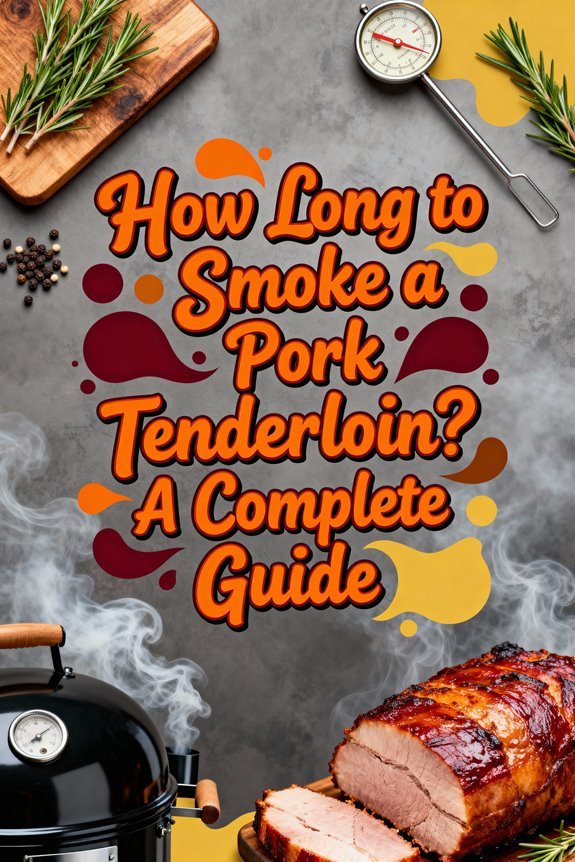You’ll need 1.5 to 2 hours per pound when smoking a Boston butt at 225°F, so expect 12 to 16 hours for an 8-pound roast. Your target internal temperature is 195°F to 203°F for perfectly tender, pull-apart meat. Plan for a temperature stall between 150°F and 170°F that can last 2 to 4 hours. Wrapping in foil at 160°F helps push through this plateau. The techniques for managing temperature fluctuations and achieving ideal bark development will guarantee consistent results.
Understanding Boston Butt and Why It’s Perfect for Smoking
Boston butt, despite its misleading name, comes from the upper portion of the pig’s front leg and includes the neck-end half of the shoulder along with parts of the shoulder blade. The cut characteristics make it ideal for smoking: its rectangular, uniform shape guarantees even cooking, while the thick fat cap and internal marbling provide essential moisture during extended cooking sessions. When you’re applying proper smoking techniques at 225°F to 250°F, this fat renders slowly, basting the meat throughout the 8 to 12-hour process. The connective tissue breaks down into gelatin, transforming tough fibers into tender, pull-apart strands. This combination of fat content, marbling, and uniform composition delivers consistently juicy results that other cuts simply can’t match. For optimal results, selecting woods like hickory or cherry adds distinct smoky flavors to complement the pork. You can choose to smoke your Boston butt with the chin bone in or have your butcher remove it for easier shredding after cooking. Many pitmasters enhance the meat’s flavor by applying dry rub seasonings with yellow mustard as a binding agent before smoking.
Preparing Your Pork Butt for the Smoker
Success in smoking pork butt starts with thorough preparation, transforming a raw cut into a perfectly seasoned canvas ready for the smoker. Begin by trimming fat to a quarter-inch thickness, which prevents flare-ups and guarantees even cooking. Apply a thin layer of mustard or lard as your binder—it’ll help the seasoning stick without affecting flavor. Just as with turkey, maintaining steady cooking temperatures throughout the smoking process is crucial for optimal results. Like smoking chicken drumsticks, using flavorful wood chips such as apple, hickory, or mesquite will enhance the final taste.
When applying rub, coat all surfaces generously except the fat cap. Whether you’re using a complex spice blend or simple salt and pepper, work it into every crevice. For best results, refrigerate the seasoned meat overnight to allow the flavors to penetrate deeply. Let the seasoned pork butt rest at room temperature for 30 minutes before smoking, allowing the meat to cook evenly from start to finish. This preparation window also gives you time to preheat your smoker to 250°F-300°F.
Choosing the Right Wood for Optimal Flavor
With your pork butt trimmed, seasoned, and ready for the smoker, selecting the right wood becomes your next decision point. Wood selection directly impacts your pulled pork’s final flavor profile.
Hickory delivers intense smoke with bacon-like aroma, burning hot and slow for deep flavor. Oak provides earthy, peppery undertones with steadier burns ideal for 12-16 hour smokes. Cherry and apple woods offer mild sweetness and fruity smoke profiles that complement rather than overpower pork. Similar to electric smoker temperatures, maintain consistent heat between 250-275°F for optimal results.
For best results, blend woods strategically. Combine oak with apple or cherry to balance rich, earthy elements with subtle sweetness. Mix hickory with fruit woods to mellow intensity while maintaining depth. A proper smoke should take approximately 1.5 to 2 hours per pound of meat until tender.
Plan wood chunks carefully—each lasts approximately one hour, requiring systematic replacement throughout your smoke to maintain consistent smoke profiles and proper bark formation. Wood chips burn faster than chunks, making them better suited for shorter smoking sessions or smaller pork cuts.
Setting Up Your Smoker Temperature
Before placing your Boston butt on the grates, you’ll need to establish and stabilize your smoker at 225°F—the baseline temperature that transforms tough connective tissue into tender, pullable pork over the next 12-20 hours.
Use dual-probe digital thermometers for precise temperature control: one monitoring smoker air temperature, one tracking internal meat progress. Preheat your smoker 30 minutes before loading the pork, adjusting vents and fuel to eliminate fluctuations.
Maintain 225°F throughout the initial hours to maximize smoke absorption when meat surfaces are coolest and most receptive. Avoid opening the lid; each peek drops internal temperature 15-25°F and extends cook time.
If you’re using a pellet smoker, activate “super smoke” mode during preheat and early cooking stages. Once stabilized, minor adjustments keep your temperature steady without compromising bark development or moisture retention. Place a water pan in the smoker to improve the final texture of your pulled pork.
Calculating Smoking Time Based on Weight and Temperature
Although many pitmasters default to the “1.5–2 hours per pound” formula, you’ll achieve more consistent results by treating this guideline as a starting framework rather than gospel. Your 5-pound butt typically requires 6–7 hours at 225°F, while an 8-pounder extends to 8–10 hours. Smaller cuts (4–6 lbs) trend closer to 1.5 hours per pound, whereas larger cuts approach 2 hours per pound—especially bone-in varieties. Just like smoking turkey breast, maintaining consistent temperature between 225-250°F is crucial for optimal results.
Meat quality and smoking methods considerably impact these calculations. Just as with crispy grilled thighs, using a reliable meat thermometer is essential for monitoring progress. Pellet smokers generally align with charcoal timelines at 225°F, though wrapping post-stall accelerates finishing. Environmental factors—wind, cold, humidity—extend cook times unpredictably. Always prioritize internal temperature (195–207°F for pulling) over clock-watching, and build in a 2–4 hour buffer beyond your weight-based estimate to accommodate the inevitable stall. For bone-in cuts, you can test doneness by checking if the bone wiggles freely when twisted gently with tongs.
Managing the Temperature Stall During Smoking
Around the 150–170°F mark, your Boston butt’s internal temperature will flatline for 2–4 hours—a phenomenon called the stall. This happens when evaporative cooling from surface moisture temporarily halts temperature rise, much like sweat cooling your skin.
Several stall factors influence duration: airflow (more movement lowers stall temperature), humidity levels, and meat size all affect evaporation rates. You’ll need to plan for this extended phase when calculating total cook time. Much like achieving ideal chicken temperature of 175-180°F, monitoring internal temperature is crucial during the stall phase. Weather conditions can also impact your smoking session, with overcast days potentially preventing the stall from occurring altogether. Just as low and slow smoking at 225-250°F produces tender results in chicken, maintaining consistent temperature throughout the stall is essential.
Combat the stall using wrapping techniques—the Texas Crutch. Wrap your butt in foil or butcher paper at 160°F after initial smoke absorption (typically 2 hours in). This reduces evaporation and accelerates cooking while preserving moisture. Use wireless thermometers to monitor progress without opening your smoker. Continue cooking until you reach 203°F for fully rendered collagen and perfect tenderness.
When and How to Wrap Your Pork Butt
When your pork butt hits 160°F and displays a firm, mahogany-colored bark—typically 3–4 hours into your smoke—you’ve reached the ideal wrapping window. Watch for temperature signs like rendered fat beginning to ooze from the surface, confirming moisture loss has begun. Similar to smoking burgers at 350 degrees Fahrenheit, maintaining consistent temperature is crucial for even cooking. Just as internal temperature helps ensure perfectly flaky halibut, monitoring your meat thermometer closely prevents overcooking.
For wrapping techniques, lay two heavy-duty foil sheets in a plus-sign pattern beneath your butt. Fold edges tightly, creating a leak-proof seal that traps steam without softening your bark. Return the wrapped butt fat-side-up to your smoker and continue cooking until internal temperature reaches 200–205°F.
If you’ve developed exceptional bark early, you can wrap at 150°F to accelerate cooking. Alternatively, wait until 170°F for maximum crust development before sealing. Consider using butcher paper instead if you want to maintain more smoke flavor while still protecting the meat from excessive heat exposure.
Determining When Your Pulled Pork Is Done
After your wrapped pork butt returns to the smoker, you’ll need to monitor internal temperature closely to catch the narrow window between tough and overdone. Target 195°F–203°F for ideal shreddability—below this range leaves connective tissue intact, while exceeding 205°F risks drying out the meat.
Similar to smoking chicken, using a digital meat thermometer helps ensure accurate temperature readings throughout the cooking process. Perform temperature checks every 30 minutes once you reach 185°F. Insert your thermometer probe into the thickest part; it should slide through like warm butter when ready. Keep your grill vents open to maintain consistent airflow and temperature control throughout the cooking process.
Don’t rely solely on numbers. Conduct tenderness tests by twisting a fork in the meat—minimal resistance confirms doneness. The bone should pull out cleanly. At the ideal temperature range, collagen melts into gelatin, creating that signature tender texture you’re after. These tactile indicators, combined with precise temperature monitoring, guarantee perfectly pullable pork every time.
Resting, Pulling, and Serving Your Smoked Pork Butt
The moment you remove your pork butt from the smoker marks the beginning of a critical phase that’ll make or break your final product. Rest it for 1-2 hours wrapped in foil and towels inside a cooler—these resting techniques allow moisture retention through juice redistribution and continued collagen breakdown above 160°F. Monitor internal temperature; it’ll rise 5-10°F during carry-over cooking. Just as with low and slow cooking, proper temperature monitoring ensures optimal results. Proper resting prevents the meat from becoming tough. Much like safe internal temperature is crucial for smoked salmon at 145°F, monitoring your pork’s temperature is essential. For pulling tips, wait until the meat drops to 160°F before shredding with claws along the grain. Pull just before serving to preserve warmth and juices. Keep pulled pork above 140°F for food safety. For serving suggestions, use warming trays for extended service, and pair with sauces to enhance flavor and maintain moisture throughout your meal.







